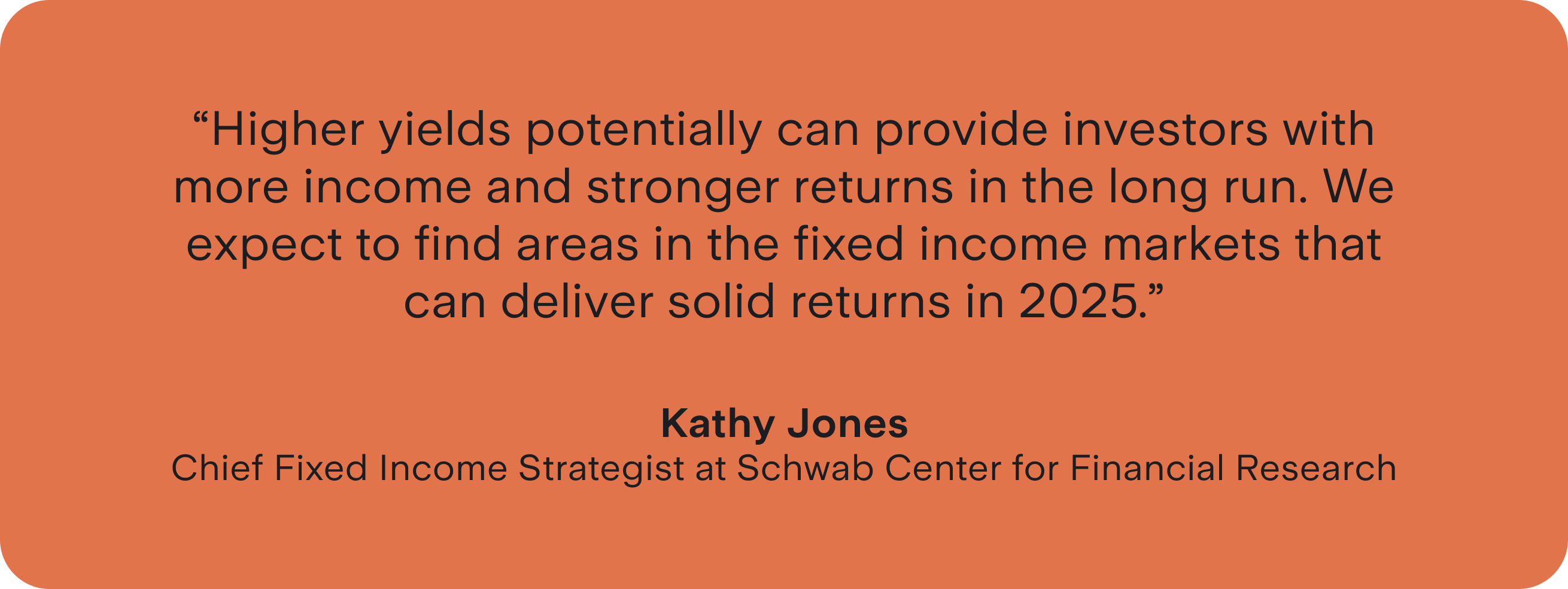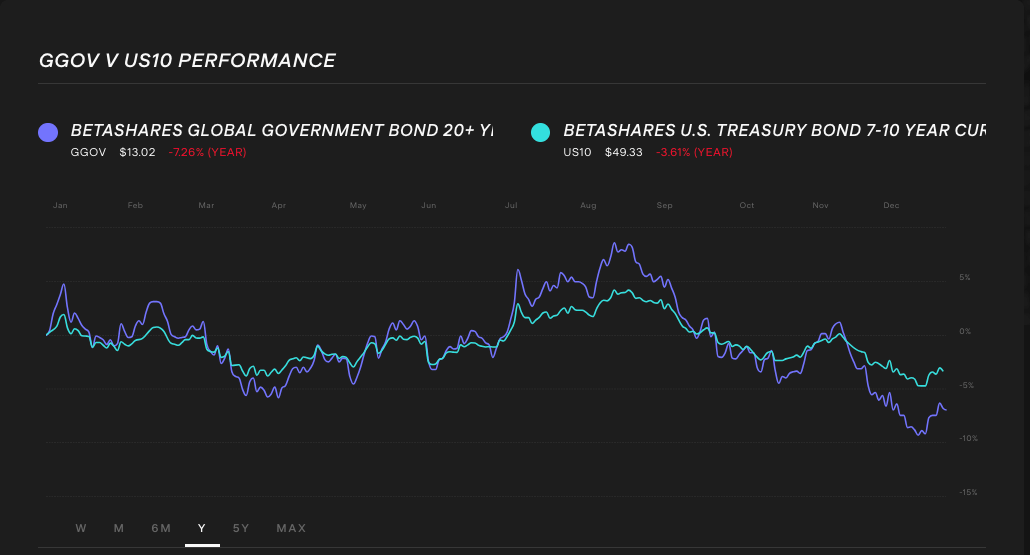
How to buy U.S. treasury bonds in Australia [2025]
The U.S. bond market is the deepest and most liquid bond market in the world. There is US$28t of U.S. government debt on issue - and growing. On one hand, the Fed is expected to cut interest rates again in 2025. This should steer yields lower. On the other hand, inflation remains sticky and debt levels continue to rise, putting upward pressure on yields. Incoming U.S. Treasury Secretary Scott Bessent wants to cut U.S. budget deficits back to 3% of GDP, a move that should slow the rise in debt. These cross currents may offer interesting opportunities for fixed income investors in 2025.
What is a treasury bond?
Bonds, treasuries or fixed income are catch-all terms used to generally describe debt issued by the U.S. government.
The U.S. Treasury issues bonds to fund government spending that can’t be financed through revenues from taxes. Funds raised from bonds cover budget deficits. Bond buyers receive a coupon – or interest payment – over the life, or maturity, of the bond.
The yield is the annual return of a bond. Investors receive their original investment back once the bond matures. There has historically been strong demand for U.S. bonds given their 'safe haven' status built on the creditworthiness of the U.S. government. It’s important to remember that bond yields and bond prices move in opposite directions.
When bond prices fall, yields go up. Higher inflation and interest rates can lower bond prices as the value of future cash flows from coupons decline.
🎓 Learn more: What are government bonds?→
What is the difference between U.S. bonds vs bills vs notes?
While the term ‘bond’ has a general meaning, there are more specific terms used by institutional investors and traders.
- A Treasury bill is government debt with a maturity of less than one year.
- A Treasury note has a maturity of 2 to 10 years.
- While Treasury bonds have maturities above 10 years.

How to buy U.S. treasury bonds in Australia?
The easiest and low-cost way to gain exposure to U.S. bonds is through an ETF.
Providers of ASX-listed ETFs include BlackRock, Betashares, Global X and VanEck. Investors can access ETFs that offer broad exposure to U.S. treasuries across different maturities.
Follow the step by step guide below on how to invest in bonds through an online investing platform.
1. Find a stock investing platform
To buy U.S. treasury bond ETFs on the ASX, you'll need to sign up to an investing platform with access to the Aussie stock market. There are several share investing platforms available, of which Stake is one.
2. Fund your account
Open an account by completing an application with your personal and financial details. Fund your account with a bank transfer, PayTo, debit card or even Apple/Google Pay.
3. Search for the ASX-listed bond ETF
Find the bond by name or ticker symbol. It is advised to conduct your own research to ensure you are purchasing the right investment product for your individual circumstances.
4. Set a market or limit order and buy the shares
Buy on any trading day using a market order, or a limit order to delay your purchase of the asset until it reaches your desired price.
5. Monitor your investment
Once you own the shares, you should monitor their performance. Check your portfolio regularly to ensure your investment is aligning with your financial goals.
Get started with Stake
Sign up to Stake and join 750K investors accessing the ASX & Wall St all in one place.
Examples of U.S. bonds listed on the ASX
There are a number of U.S. bond ETFs listed on the ASX.
- The iShares U.S. Treasury Bond ETF (AUD hedged) ETF ($IUSG) offers an investment across a broad range of maturities. Distributions are paid three times a year and the management fee is 0.15%.
- Betashares offers the Geared Long U.S. Treasury Bond Fund ($GGFD), U.S. Treasury Bond 20+ Year ETF ($GGOV), U.S. Treasury Bond 7-10 Year ETF ($US10) and the Inflation Protected U.S. Treasury Bond ETF ($$UTIP). They are all currency hedged. Betashares also offers a Geared Short U.S. Treasury Bond Fund ($BBFD), which is also currency hedged.
- Global X offers the US Treasury Bond ETF ($USTB), which is currency hedged. It pays quarterly distributions and has a 0.19% management fee.
- VanEck offers the 1-3 Month U.S. Treasury Bond ETF ($TBIL), which pays a monthly distribution and has a fee of 0.22%.

🆚 Compare: GGOV vs US10 U.S. treasury bonds over the last year→
List of popular U.S. treasury bonds
Here are two popular U.S. bonds that the market watches closely:
- 2-year note: Investors watch the 2-year note as an indicator of the direction of U.S. interest rates.
- 10-year note: This is the most closely watched by investors as a barometer of bond market sentiment.
What other types of bonds are there?
There’s more to bonds than just U.S. government debt. There are municipal bonds - or munis - that are debt issued by U.S. states, cities and local governments.
Treasury Inflation Protected Securities (TIPS) are inflated protected bonds. Agency bonds are issued by housing agencies like Freddie Mac and Fannie Mae.
Corporate bonds are another important part of the market. Corporate bonds are split into investment grade (companies with higher credit ratings) and high yield (low credit ratings). The mortgage backed securities market offers exposure to bonds backed by bundles of home loans.
How to decide what treasury bonds are right for you?
Bonds have historically been an important portfolio diversifier by providing some protection during periods of stock market weakness.
Bonds typically generate lower returns than stocks. However, coupon payments generate an income stream.
Investors tend to increase their exposure to fixed income as they age. Just remember, bond prices fall when inflation and interest rates rise.
💡Related: Discover what are the best bond ETFs in Australia to invest in→
What are the benefits of treasury bonds?
Bonds offer two main benefits: portfolio diversification and an income stream.
These are both important attributes in portfolio construction, especially as investors age and seek to lessen their risks and provide additional income. However, bonds do have risks.
The period of low interest rates since the Global Financial Crisis, and especially during the pandemic, crushed yields and income. The resurgence of inflation and higher rates has weighed on bond prices and pushed yields higher.
Treasury bonds definitions to know
Here are some common terms you will see when researching bonds:
- Coupon: Total interest payment over a year.
- Distribution frequency: How frequently a U.S. bond ETF pays a distribution.
- Maturity: The length of the bond, usually in years.
- Running yield: The annual coupon payment divided by the current price.
- Weighted average coupon: The average coupon rate of an ETF’s bonds based on weighting.
- Yield to maturity: The total return of a bond if held to maturity.
U.S. treasury bonds FAQs
Investors should consider bonds for portfolio diversification and as a source of income.
U.S. bond ETFs pay distributions. These are funded by cash flows from bonds held in the ETF portfolio.
As these U.S. bond ETFs are listed on the ASX you can invest as much or as little as you like. However, your first investment will have to be a minimum of $500 under the CHESS model (more on the Minimum Marketable Parcel). All following orders for the same security can be as small as $20.
Yes, there is a 1-year treasury bill.
Yes, there is a 10-year treasury note. The 10-year yield is one of the most closely tracked numbers in global markets.
This article was edited by Robert Guy - Senior Markets Writer at Stake.
Disclaimer
The information contained above is not financial product advice nor a recommendation to invest in any of the securities listed. Past performance is not a reliable indicator of future performance. When you invest, your capital is at risk. You should consider your own investment objectives, financial situation and particular needs. The value of your investments can go down as well as up and you may receive back less than your original investment. As always, do your own research and consider seeking appropriate financial advice before investing.
Any advice provided by Stake is of general nature only and does not take into account your specific circumstances. Trading and volume data from the Stake investing platform is for reference purposes only, the investment choices of others may not be appropriate for your needs and is not a reliable indicator of performance.
$3 brokerage fee only applies to trades up to $30k in value (USD for Wall St trades and AUD for ASX trades). Please refer to hellostake.com/pricing for other fees that are applicable.


